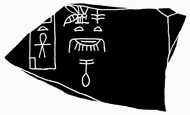Nubnefer
| Name of Nubnefer | |
|---|---|
 Shard of the Nubnefer
|
|
| Throne name |
style = "text-align: center" |
Nubnefer ( Nub-nefer ), also Nebu-nefer , is the maiden name of an ancient Egyptian king ( pharaoh ) of the 2nd Dynasty ( early Dynasty ). Information about the time of reign, length of reign and relations with the rulers of the 2nd dynasty are currently impossible, as he is not mentioned in any known king list and could not yet be linked to one of the contemporary Horus names.
Evidence
The name Nubnefer is only documented by two fragments of slate that come from the large western galleries of the pyramid necropolis of King Djoser (beginning of the 3rd dynasty ) in Saqqara .
identity
Since "Nubnefer" has so far only been handed down as a birth name, there is disagreement in research about when this ruler ruled and who his predecessors and successors were. For this reason, there are several attempts to link it with Horus names that have already been archaeologically proven.
In the past, Nubnefer was preferred to be associated with the Horus name Nebre , which, however, never went unchallenged. The reason for the earlier explanation was the Ramessid cartouche name Wadjenes , which is presented in the royal lists of ancestors as the direct successor of the Ninetjer. Since none of the previously archaeologically proven Horus names could be linked to the name "Wadjenes", it was assumed that it must be traced back to a prescription. The archaeologically extensively documented throne name " Nisut-Biti-Nebti Weneg " was the originator, as the Weneg flower in the hieratic script in italics is very similar to the Gardiner special character M13B ( papyrus stem with two leaves at the base). Ramesside scribes would therefore have misinterpreted the name "Weneg-Nebti" as "Wadjenes". For the name "Nubnefer" - as a makeshift - King Nebre was looking for a suitable counterpart to the Ramessid cartouche name Kakau . This in turn is presented in the ancestral lists as the direct predecessor of Ninetjer and is therefore actually to be linked with Nebre. Therefore, for a long time it was believed that “Kakau” was a reading of “Nubnefer”.
In 2007, Jochem Kahl managed to link Nebre's name with the throne name of Weneg. Kahl proved that Weneg's name was originally next to the Horus name of Nebre, but was then overwritten by Ninetjer. Therefore, it is now increasingly assumed in Egyptology that Weneg and Nebre are identical to one another. On the two artefacts that bear Nubnefer's name, a building called Menti-Anch is also mentioned, which was verifiably only founded under Ninetjer , the third ruler of the 2nd dynasty. Nubnefer can therefore only have ruled parallel to Ninetjer on the one hand or only after him on the other. This knowledge supports the statements of Wolfgang Helck , Peter Kaplony and Toby Wilkinson , who consider Nubnefer as a direct or indirect successor of the Ninetjer, with Wolfgang Helck Nubnefer as the third successor of the Ninetjer after the kings Wadjenes and Sened . IES Edwards is convinced that Nubnefer may be identical to King Ninetjer. Jochem Kahl is unsure, but points to a possible connection with King Sa , which he himself rates with a "?".
literature
- Wolfgang Helck : Dating of the vessel inscriptions from the Djoser pyramid . In: Journal for Egyptian Language and Antiquity (ZÄS) 106 . Akademie, Berlin 1979, pp. 120-132.
- Wolfgang Helck: Investigations on the Thinite Age (= Ägyptologische Abhandlungen. (ÄA) Vol. 45). Harrassowitz, Wiesbaden 1987, ISBN 3-447-02677-4 .
- Jochem Kahl : Inscriptional Evidence for the Relative Chronology of Dyn. 0-2. In: Erik Hornung, Rolf Krauss, David A. Warburton (eds.): Ancient Egyptian Chronology (= Handbook of Oriental studies. Section One. The Near and Middle East. Volume 83). Brill, Leiden / Boston 2006, ISBN 978-90-04-11385-5 , pp. 94-115 ( online ).
- Jochem Kahl: "Ra is my Lord": Searching for the Rise of the Sun God at the Dawn of Egyptian History . Harrassowitz, Wiesbaden 2007, ISBN 3-447-05540-5 , pp. 7-12 and 21.
- Peter Kaplony : A building named Menti-Ankh. In: Communications from the German Archaeological Institute, Cairo Department (MDAIK). Vol. 20, 1965, ISSN 0342-1279 .
- Pierre Lacau, Jan-Phillip Lauer: La Pyramide à Degrés IV. - Inscriptions gravées sur les Vases: Fouilles à Saqqarah . Service des antiquités de l'Égypte, Cairo 1936, plate 4.
- Toby Wilkinson: Early Dynastic Egypt: Strategy, Society and Security . Routledge, London 1999, ISBN 0-4151-8633-1 .
Individual evidence
- ↑ after: P. Lacau, J.-P. Lauer: La Pyramide à Degrés IV . Cairo 1936, plate 4.
- ^ A b Peter Kaplony : A building named Menti-Ankh. 1965, pp. 41-46.
- ↑ P. Lacau, J.-P. Lauer: La Pyramide à Degrés IV. Cairo 1936, plate 4.
- ↑ a b c Jochem Kahl: "Ra is my Lord". ... Wiesbaden 2007, pp. 7–12 and 21.
- ^ IES Edwards : The early dynastic period in Egypt (= Cambridge ancient history. ) Cambridge University Press, Cambridge 1964, p. 25.
- ↑ Wolfgang Helck: Dating of the vessel inscriptions from the Djoser pyramid . Pp. 131-132; Toby Wilkinson: Early Dynastic Egypt: Strategy, Society and Security . P. 89.
- ^ Peter Kaplony: A building named Menti-Ankh . 1965, pp. 1-46.
- ^ IES Edwards: The early dynastic period in Egypt. Cambridge University Press, Cambridge 1964, p. 25.
- ↑ Jochem Kahl: "Ra is my Lord". ... Wiesbaden 2007, p. 9.
| predecessor | Office | successor |
|---|---|---|
| unsure |
King of Egypt 2nd Dynasty |
unsure |
| personal data | |
|---|---|
| SURNAME | Nubnefer |
| ALTERNATIVE NAMES | Nub-nefer; Nebu-nefer |
| BRIEF DESCRIPTION | ancient Egyptian king of the 2nd dynasty |
| DATE OF BIRTH | between 30th century BC BC and 28th century BC Chr. |
| DATE OF DEATH | between 29th century BC BC and 27th century BC Chr. |